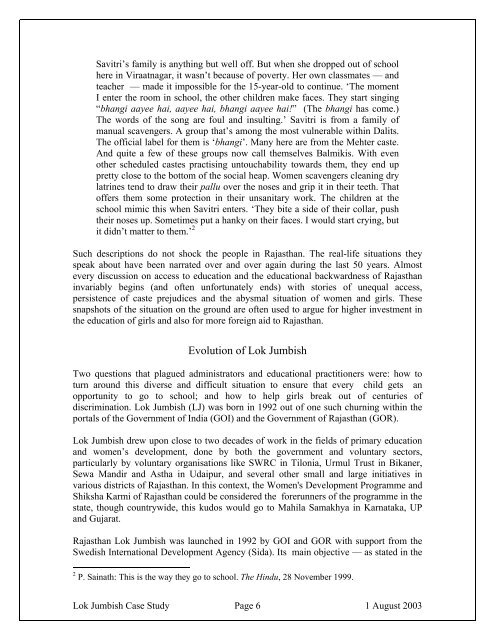LOK JUMBISH - RAJASTHAN
LOK JUMBISH - RAJASTHAN
LOK JUMBISH - RAJASTHAN
You also want an ePaper? Increase the reach of your titles
YUMPU automatically turns print PDFs into web optimized ePapers that Google loves.
Savitri’s family is anything but well off. But when she dropped out of schoolhere in Viraatnagar, it wasn’t because of poverty. Her own classmates –– andteacher –– made it impossible for the 15-year-old to continue. ‘The momentI enter the room in school, the other children make faces. They start singingkHhangi aayee haiY aayee haiY Hhangi aayee haiZl (The Hhangi has come.)The words of the song are foul and insulting.’ Savitri is from a family ofmanual scavengers. A group that’s among the most vulnerable within Dalits.The official label for them is ‘Hhangi’. Many here are from the Mehter caste.And quite a few of these groups now call themselves Balmikis. With evenother scheduled castes practising untouchability towards them, they end uppretty close to the bottom of the social heap. Women scavengers cleaning drylatrines tend to draw their :allu over the noses and grip it in their teeth. Thatoffers them some protection in their unsanitary work. The children at theschool mimic this when Savitri enters. ‘They bite a side of their collar, pushtheir noses up. Sometimes put a hanky on their faces. I would start crying, butit didn’t matter to them.’ 2Such descriptions do not shock the people in Rajasthan. The real-life situations theyspeak about have been narrated over and over again during the last 50 years. Almostevery discussion on access to education and the educational backwardness of Rajasthaninvariably begins (and often unfortunately ends) with stories of unequal access,persistence of caste prejudices and the abysmal situation of women and girls. Thesesnapshots of the situation on the ground are often used to argue for higher investment inthe education of girls and also for more foreign aid to Rajasthan.Evolution of Lok JumbishTwo questions that plagued administrators and educational practitioners were: how toturn around this diverse and difficult situation to ensure that every child gets anopportunity to go to school; and how to help girls break out of centuries ofdiscrimination. Lok Jumbish (LJ) was born in 1992 out of one such churning within theportals of the Government of India (GOI) and the Government of Rajasthan (GOR).Lok Jumbish drew upon close to two decades of work in the fields of primary educationand women’s development, done by both the government and voluntary sectors,particularly by voluntary organisations like SWRC in Tilonia, Urmul Trust in Bikaner,Sewa Mandir and Astha in Udaipur, and several other small and large initiatives invarious districts of Rajasthan. In this context, the Womenms Development Programme andShiksha Karmi of Rajasthan could be considered the forerunners of the programme in thestate, though countrywide, this kudos would go to Mahila Samakhya in Karnataka, UPand Gujarat.Rajasthan Lok Jumbish was launched in 1992 by GOI and GOR with support from theSwedish International Development Agency (Sida). Its main objective –– as stated in the2 P. Sainath: This is the way they go to school. [he \indu, 28 November 1999.Lok Jumbish Case Study Page 6 1 August 2003












